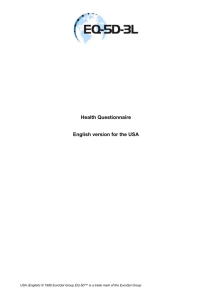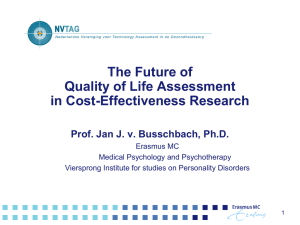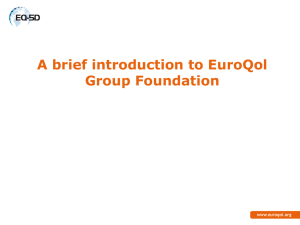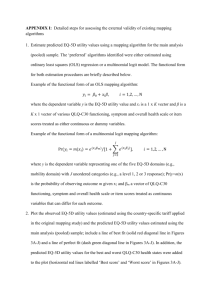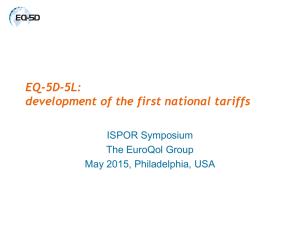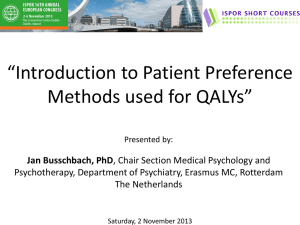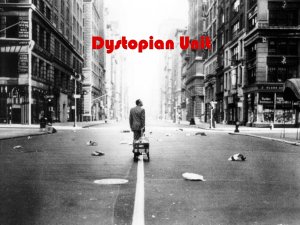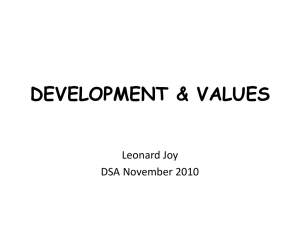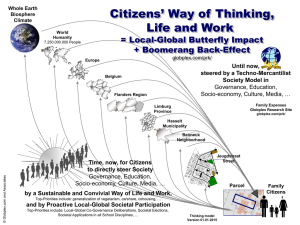Singapore introduction to EQ-5D
advertisement
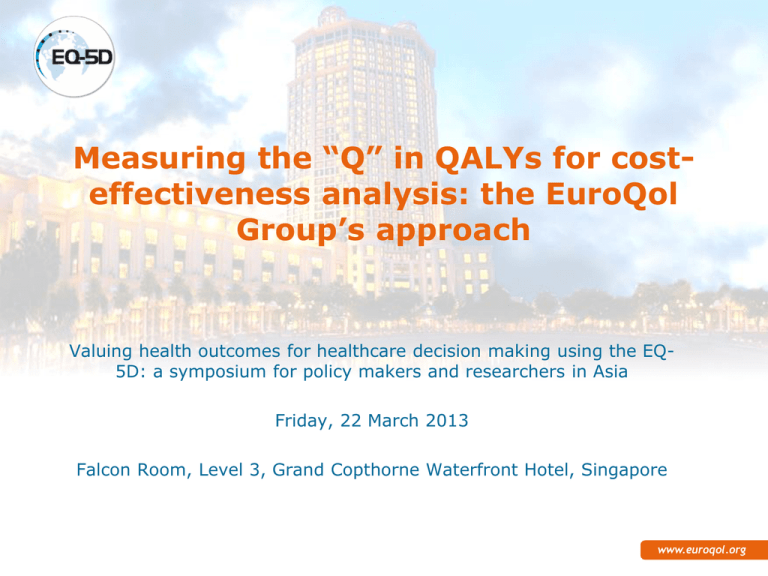
Measuring the “Q” in QALYs for costeffectiveness analysis: the EuroQol Group’s approach Valuing health outcomes for healthcare decision making using the EQ5D: a symposium for policy makers and researchers in Asia Friday, 22 March 2013 Falcon Room, Level 3, Grand Copthorne Waterfront Hotel, Singapore Prof. Dr. Jan J.V. Busschbach • Chair of the EuroQol Research Foundation • Erasmus MC – Psychiatry • Section Medical Psychology and Psychotherapy – J.vanbusschbach@erasmusmc.nl Slides: www.busschbach.com 3 The EQ-5D-3L questionnaire ‘Simplified’ Chinese version The EQ-5D-3L questionnaire To help people say how good or bad a health state is, we have drawn a scale (rather like a thermometer) on which the best state you can imagine is marked 100 and the worst state you can imagine is marked 0. We would like you to indicate on this scale how good or bad your own health is today, in your opinion. Please do this by drawing a line from the box below to whichever point on the scale indicates how good or bad your health state is today. Your own health state today Best imaginable health state 100 9 0 8 0 7 0 6 0 5 0 4 0 3 0 2 0 1 0 0 Worst imaginable health state 5 EuroQol jargon: state 11232 6 Moving from 3 levels to 5… 7 New developments • Developing the 5 level ‘EQ-5D-5L’ • Improving the validation – New methodology • Standardizing the validation – Standardizing methodology – Allowing cultural values 8 The EuroQol Group • Founded 25 years ago • A network of about 100… – International, – multi-disciplinary, – researchers • Devoted to… – measurement of health status, – health related Quality of Life 9 Still ‘Euro’? • • • • • • • • • • Australia Canada Denmark Finland France Germany Greece Italy Netherlands New Zealand • • • • • • • • • • Norway Poland Singapore Slovenia South Africa Spain Sweden Trinidad & Tobago United Kingdom United States 10 Non commercial • An non profit organization – A foundation – No stock holders – Members votes for a Executive Board • The EuroQol Office – Executive Director: Dr. Bernhard Slaap – www.euroqol.org • All money goes into research 11 Income • Pharmaceutical industry – Subscriptions for 3 years • Non commercial users – Sometimes fees • Any research – Free 12 EuroQol Membership • Reserved for those who actively support the work of the EuroQol Group and make a positive and sustained commitment to it • Attend and scientifically contribute to the EuroQol Plenary Meetings and participate in Working Groups • Access to research grants and annual meeting 13 EuroQol Annual Plenary Meeting 14 EuroQol Annual Meeting • Present papers and posters on: – – – – Methodological / valuation aspects of EQ-5D Development of new EQ-5D versions Alternative modes of administration Use of EQ-5D in health population surveys 15 EuroQol Executive Office 16 EuroQol Office • Handles EQ-5D license requests • Scientific support clients • Scientific and operational support EQ sponsored studies • EQ members support • Based in Rotterdam – The Netherlands • 5.0 FTE + contractors 17 Translation Protocol 1) Two versions in target language 1. Forward Translation Translators should be native in target language and fluent in English 2) First consensus version 3) Report to EuroQol Group 1) Two versions in English Translators should be native in English 2. Backward Translation and fluent in target language 2) Comparison to the original English version 3) Second consensus version 4) Report to EuroQol Group 1) Test second consensus by 8 lay respondents 3. Respondent Testing - Native to the target language - Patients and healthy persons - Range of socio-demographic characteristics 2) Third consensus version 3) Report to EuroQol Group Final translation of EQ-5D 18 Certified language versions • All produced following recommended guidelines for cultural adaptation + rating scale exercise • Translation certificates provided for all versions -19- EQ-5D User Guides 20 EQ-5D Paper version EQ-5D-3L descriptive system EQ-5D-3L VAS To help people say how good or bad a health state is, we have drawn a scale (rather like a thermometer) on which the best state you can imagine is marked 100 and the worst state you can imagine is marked 0. We would like you to indicate on this scale how good or bad your own health is today, in your opinion. Please do this by drawing a line from the box below to whichever point on the scale indicates how good or bad your health state is today. Your own health state today Best imaginable health state 100 9 0 8 0 7 0 6 0 5 0 4 0 3 0 2 0 1 0 0 Worst imaginable health state 21 Other formats Tablet, PDA, Web -22- Other formats Tablet, PDA, Web -23- EQ-5D Web 24 EuroQol instruments • EQ-5D-3L Translations – More than 160 languages in Self-complete paper format – Also available in; Telephone, Face-to-face, Proxy, IVR, Web and Tablet format • EQ-5D-5L Translations – More than 90+ languages in self-complete paper format – Also available in Web and Tablet format • EQ-5D-Y Translations – Available in more than 20 languages – Youth between 7-12 years 25 Overview of the EQ-5D Purpose and origins of the descriptive system 26 Health Economics • Comparing different allocations – Should we spent our money on • Wheel chairs • Screening for cancer – Comparing costs – Comparing outcome • Outcomes must be comparable – Make a generic outcome measure 27 Outcomes in health economics • Specific outcome are incompatible – Allow only for comparisons within the specific field • Clinical successes: successful operation, total cure • Clinical failures: “events” – “Hart failure” versus “second psychosis” • Generic outcome are compatible – Allow for comparisons between fields • Life years • Quality of life • Most generic outcome – Quality adjusted life year (QALY) 28 Quality Adjusted Life Years (QALY) • Example 1.00 – – – – Blindness Time trade-off value is 0.5 Life span = 80 years 0.5 x 80 = 40 QALYs X 0.5 x 80 = 40 QALYs 0.00 40 80 Life years Area under the curve 30 QALY league tables Intervention $ / QALY GM-CSF in elderly with leukemia 235,958 EPO in dialysis patients 139,623 Lung transplantation 100,957 End stage renal disease management 53,513 Heart transplantation 46,775 Didronel in osteoporosis 32,047 PTA with Stent 17,889 Breast cancer screening 5,147 Viagra 5,097 Treatment of congenital anorectal malformations 2,778 31 9000 Citations in PubMed 1980[pdat] AND (QALY or QALYs) 1200 Publications 1000 800 600 400 200 0 1970 1980 1990 2000 2010 2020 32 Most controversy about the ‘Q’ in QALY • An uni-dimensional value – Like temperature, of km/h – Like the IQ-test measures intelligence • Ratio or interval scale – Difference 0.00 and 0.80… – … must be 8 time higher than 0.10 33 Unidimensional, ratio scales • Two popular methods have these pretensions – Time trade-off – Standard gamble • Two methods are less clear…. – Visual analog scale – Paired comparison • Conjoint analysis; DCE, etc 34 The Rosser & Kind Index 35 The Rosser & Kind index • One of the oldest valuation • 1978: Magnitude estimation – Magnitude estimation PTO / VAS – N = 70 • Doctors, nurses, patients and general public • 1982: Transformation to “utilities” – On a 0.00 to 1.00 scale – Could be used for QALYs 36 1985: High impact article 37 1985: High impact article 38 1985: High impact article – Survey at the celebration of 25 years of health economics in the UK (HESG): chosen most influential article on health economics 39 Criticism on the Matrix • Sensitivity – only 30 health states • The unclear meaning of “distress” • The involvement of medical personnel • No clear way how to classify the patients – into the matrix • Only British values • The compression of states in the high values 40 Value compression 41 New initiatives • Higher sensitivity (more then 30 states) • More and better defined dimensions • Other valuation techniques – Standard Gamble, Time Trade-Off, Visual Analogue Scale • Values of the general public • A questionnaire… – to allow patients to ‘self classify’ themselves • An international standard – to allow international comparisons – That is at that time “Europe” 42 EuroQoL Group • First meeting 1987 • Participants from – UK, Finland, Sweden, The Netherlands • A common core instrument – To standardize the instrument • But allow different national values – To allow international comparisons – To allow linking of international results • Instrument should be small • Suitable for sever ill patients – The emerging of high tech medicine, especially transplantation 43 The first EuroQol • Higher sensitivity (more then 30 states) – 216 states • More and better defined dimensions – 6 dimensions (EQ-6D) – – – – – – Mobility; Daily activity and self care; Work performance Family and leisure performance Pain/discomfort Present mood • Visual Analogue Scale 44 The first EuroQol • Values of the general public – Values from general public – But also values from patients (!) • A questionnaire – to allow patients to ‘self classify’ themselves • A international standard – to allow international comparisons – That is at that time “Europe” 45 Values from the patients 46 Values from the general public 47 First values general public Why values of the general public? • Original: To avoid ‘strategic responses’ – Patients pressure groups • To avoid coping – Underestimating the value of health • To allow complex utility assessments – – – – – Time Trade Off Standard Gamble Willingness to pay Person Trade off Paired comparisons (DCE) • To allow for societal values of health states – Like costs: the societal perspective 49 Why indirect utility measures? • Original: To avoid ‘strategic responses’ – Patients pressure groups • To avoid coping – Underestimating the value of health • To allow complex utility assessments – – – – – Time Trade Off Standard Gamble Willingness to pay Person Trade off Paired comparisons (DCE) • To allow for societal values of health states – Like costs: the societal perspective 50 Coping: can be a problem in the patient perspective…. • Stensman Healthy – Scan J Rehab Med 1985;17:87-99. • Scores on a visual analogue scale – 36 subjects in a wheelchair – 36 normal matched controls • Mean score – Wheelchair: 8.0 – Health controls: 8.3 • Need for indirect valuation Death 51 Why values of the general public? • Original: To avoid ‘strategic responses’ – Patients pressure groups • To avoid coping – Underestimating the value of health • To allow complex utility assessments – – – – – Time Trade Off Standard Gamble Willingness to pay Person Trade off Paired comparisons (DCE) • To allow for societal values of health states – Like costs: the societal perspective 52 Time Trade-Off • TTO: alternative for VAS • Wheelchair – With a life expectancy: 50 years • How many years would you trade-off for a cure? – Max. trade-off is 10 years • QALY(wheel) = QALY(healthy) – Y * V(wheel) = Y * V(healthy) – 50 V(wheel) = 40 * 1 • V(wheel) = .80 53 Health economics prefer TTO • Visual analogue scale – No trade-off: no relation to QALY • No interval proportions – Easy • Time trade-Off – Trade-off: clear relation to QALY • Interval proportions – Less easy • Time consuming in patients • Need for indirect valuation 54 Why values of the general public? • Original: To avoid ‘strategic responses’ – Patients pressure groups • To avoid coping – Underestimating the value of health • To allow complex utility assessments – – – – – Time Trade Off Standard Gamble Willingness to pay Person Trade off Paired comparisons (DCE) • To allow for societal values of health states – Like costs: the societal perspective 55 The economic perspective • In a normal market: the consumer values count • The patient seems to be the consumer – Thus the values of the patients…. • If indeed health care is a normal market… • But is it….? 56 Health care is not a normal market • Supply induced demands • Government control – Financial support (egalitarian structure) • Patient Consumer – The patient does not pay • Consumer = General public – Potential patients are paying • Health care is an insurance market – A compulsory insurance market 57 Health care is an insurance market • Values of benefit in health care have to be judged from a insurance perspective • Who values should be used the insurance perspective? 58 Who determines the payments of unemployment insurance? • Civil servant – Knowledge: professional – But suspected for strategical answers • more money, less problems • identify with unemployed persons • The unemployed persons themselves – Knowledge: specific – But suspected for strategical answers • General public (politicians) – Knowledge: experience – Payers 59 Who’s values (of quality of life) should count in the health insurance? • Doctors – Knowledge: professional – But suspected for strategical answers • See only selection of patient • Identification with own patient • Patients – Knowledge: disease specific – But suspected for strategical answers – But coping • General public – Knowledge: experience – Payers – Like costs: the societal perspective 60 The general public should be informed… • Valuing without knowledge makes no sense – Thyroid Eye Disease • Give description of the disease – For instance in terms of the EQ-5D A patient with bilateral thyroid eye disease with upper lid retraction and exophthalmos. 61 Why indirect utility measures? • Original: To avoid ‘strategic responses’ – Patients pressure groups • To avoid coping – Underestimating the value of health • To allow complex utility assessments – – – – – Time Trade Off Standard Gamble Willingness to pay Person Trade off Paired comparisons (DCE) • To allow for societal values of health states – Like costs: the societal perspective 62 Indirect utility measrue MOBILITY I have no problems in walking about I have some problems in walking about I am confined to bed SELF-CARE I have no problems with self-care I have some problems washing or dressing myself I am unable to wash or dress myself USUAL ACTIVITIES (e.g. work, study, housework family or leisure activities) I have no problems with performing my usual activities I have some problems with performing my usual activities I am unable to perform my usual activities PAIN/DISCOMFORT I have no pain or discomfort I have moderate pain or discomfort I have extreme pain or discomfort ANXIETY/DEPRESSION I am not anxious or depressed I am moderately anxious or depressed I am extremely anxious or depressed 63 EQ-5D-3L Value Sets TTO Value Sets VAS Value Sets 1 1 0.8 0.8 0.6 0.4 0.2 0 -0.2 -0.4 Value Denmark Germany Japan Netherlands Spain UK USA Zimbabwe Belgium Denmark Finland New Zealand Slovenia Spain UK Europe 0.4 0.2 0 -0.2 -0.6 -0.8 Health State Health State 64 33333 33321 22233 22323 32211 21232 11122 11112 11121 11211 12111 21111 11111 33333 33321 22233 22323 32211 21232 11122 11112 11121 11211 12111 21111 -0.4 11111 Value 0.6 Values from the patients 65 Values from the general public 66 Why use the EQ-5D? What are the alternatives? 67 Validated questionnaires Rosser & Kind EuroQol EQ-5D www.euroqol.org QWB SF-36 (SF-6D) www.sf-36.org HUI Mark 2 HUI Mark 3 www.healthutilities.com 15D www.15d-instrument.net 68 The Rosser & Kind Index 69 The Rosser & Kind index • Criticism on the Rosser & Kind index – Sensitivity (only 30 health states) • New initiatives – Higher sensitivity (more then 30 states) • EuroQol Group – EQ-5D-3L and the EQ-5D-5L • McMaster University – Health Utility Index 2 & 3 • SF-36 – SF-6D 70 Health Utility Index • Developed from pediatric care – Strong proxy versions • Symptom driven: – “Outside the skin” instead of “inside the skin” • EQ-5D: “problems with daily activity” • HUI: “Unable to read ordinary newsprint…” • Commercial – All user have to pay • 35 Translations 71 HUI 2 72 HUI 3 73 Increasing number of health states Questionnaire Number of states Rosser & Kind Matrix 30 EQ-5D 3L 243 Quality of Well Being Scale (QWB) 2,200 EQ-5D 5L 3,125 SF-6D (SF-36) 18,000 HUI Mark 2 24,000 HUI Mark 3 972,000 15 D 3,052,000,000 74 No longer value all states • Impossible to value all health states – If one uses more than 30 health states • Estimated the value of the other health states with statistical techniques – Statistically inferred strategies • Regression techniques • EuroQol, Quality of Well-Being Scale (QWB) – Explicitly decomposed methods • Multi Attribute Utility Theory (MAUT) • Health Utility Index (HUI) 75 Regression techniques • Value a sample of states empirically • Extrapolation – Statistical methods, like linear regression – 11111 = 1.00 – 11113 = .70 – 11112 = ? 76 Gets complex if states increases • Moving from 3 levels to 5…. • Extrapolation – Statistical methods, like linear regression – 11111 = 1.00 – 11115 = .70 – 11112 = ? – 11113 = ? – 11114 = ? 77 More health states, more assumptions • General public values at the most 50 states • The ratios empirical (50) versus extrapolated – – – – – – – Rosser & Kind EQ-5D 3L QWB EQ-5D 5L SF-36 HUI (Mark III) 15D 1:1 1:5 1:44 1:62 1:360 1:19,400 1:610,000,000 • What is the critical ratio for a valid validation? 78 Conflicting evidence sensitivity SF-6D Liver transplantation, Longworth et al., 2001 79 SF-36 as utility instrument • • • • Transformed into SF6D SG N = 610 Inconsistencies in model – 18.000 health states – regression technique stressed to the edge • Floor effect in SF6D 80 Some levels in the SF-6D do not work… Dimension: Physical Functioning (PF) If PF=1 decrement: 0 If PF=2 decrement: - 0.056 If PF=3 decrement: - 0.056 If PF=4 * decrement: - 0.072 If PF=5 * decrement: - 0.080 If PF=6 * decrement: - 0.134 Dimension: Role Limitations (RL) If RL=1 decrement: 0 If RL=2 decrement: - 0.073 If RL=3 * decrement: - 0.073 If RL=4 * decrement: - 0.073 81 SF-6D loses a lot of levels • Proposed Levels – – – – – – PF RL SF PN MH VI Actual levels 6 4 5 6 5 5 • Proposed Levels 5 2 5 5 4 3 : 18.000 – 6x4x5x6x5x5 • Actual levels : 480 – 5x2x5x5x4x3 82 EQ-5D • Strong punts – – – – – – – Very sensitive in the low Measures subjective burden (inside the skin) Low administrative burden Many translations Cheap Most used QALY questionnaire Most international validations • Weak points – Only there levels per dimensions – Insensitive in the high regions 83 HUI • Strong punts – – – – Sensitive Measures objective burden (outside the skin) Well developed proxy versions Well developed child versions • Weak points – Expensive – Only a few valuation studies 84 SF-6D • Strong punts – Probably sensitive in the high regions – Often already include in trials (SF-36) – Many translations • Weak points – Insensitive in the low regions – Only a few validation study – Might be expensive 85 Conclusions • More states better sensitivity • The three leading questionnaires – have different strong and weak points 86
